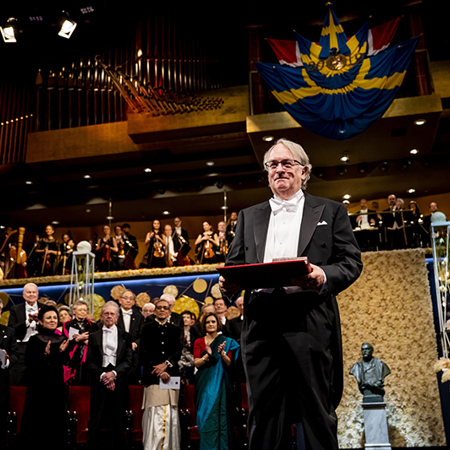PA: When did you realize the significance to the energy landscape of your discovery of the intercalation (housing) of lithium ions in a host material?
SW: Early on. Because our first paper was published in Science and that is not easy to get into. The particular material that we worked on was titanium disulphide which, at a molecular level, has spaces that can house – intercalate – lithium ions. Exxon made small cells for some applications. The price went down, and Exxon lost interest and licensed to Sony. Sony then developed the lithium-ion rechargeable battery for all the electronic gadgets. Right now, most systems are 80% nickel, 10% Mn, 10% Co.
PA: Do you think a Nobel Prize was overdue?
SW: People have commented on it. John Goodenough was the oldest person to receive a Nobel prize. We were happy that he lived long enough to accept it.
PA: What were the key challenges you faced during the process of developing the lithium-ion battery?
SW: The biggest challenge is that we made all the inventions. All the battery intellectual property is American or British but then everything got moved to Asia because Europeans and Americans did not want to invest the money in learning how to manufacture. The huge issue we face now is that we have no supply chain in the U.S. for materials, trained people or manufacturing facilities.
We just received 113 million dollars from the federal government of New York State to build a prototyping facility in an old IBM building and 12 million dollars to train the workforce. That is what is missing in North America.
PA: You are currently working on the impact of Nb coating/substitution in Ni-rich cathode materials. How does the modification with Nb affect the overall battery performance?
SW: We know that 60% nickel is stable in the air and works well. However, once the nickel content reaches 80%, stability in the air becomes compromised. This means we have to control the atmosphere more as the reactivity with the battery electrolyte increases so we lose capacity fairly fast. We started stabilizing the 80% nickel by adding valence elements. We found niobium works best. We got several hundred cycles out of 90% Ni (NMC 9055) with about 1% Nb. You do not need more than that. It looks like Nb stops the cracking of those cathode particles , and there is no capacity loss over several hundred cycles. The results are published in our 2022 open access paper: Electrochemical characterization and microstructure evolution of Ni-rich layered cathode materials by niobium coating/substitution
PA: What are the next steps for this research?
SW: The next step is to study behavior at different temperatures and see if we can get to 800-1000 cycles, meaning build bigger cells for EVs. The theoretical energy density possible for high-nickel cathodes should be 1000 Wh/kg. In reality the cell is at 250 Wh/kg, so we are only getting 25%. The goal is to get up to 500 Wh/kg to double the energy density. We are also doing some research funded by the U.S. army to see how well the Nb-coated NMC behaves at higher and lower temperatures.
PA: Do you have the infrastructure to achieve this at Binghamton?
SW: We have one of the few dry rooms and pouch cells manufacturing facilities in the U.S. within a University.
I work as part of Battery500, a large consortium of national labs and academic institutions, so we work closely together with them. We are going to scale up.
PA: We discussed cathodes, but we know that electrolytes are also important. Can you tell us about your recent studies on the impact of different electrolytes on nickel-rich cathodes?
SW: One of the things we are doing in the Battery500 is getting rid of the graphite anode so we are using pure Li metal. Pure Li metal does not plate-out well from the carbonate electrolyte presently used in Li ion. We developed a new electrolyte which is really based on the old Exxon electrolyte. The new electrolyte is organic ethers, with a new salt LiFSI included. The ether plate-out Li is much better than the carbonate. We have been looking at how stable those systems are. Do they react with Li or high nickel? So, we embarked on a thermal stability study. Our major goals in Battery500 right now are to study the stability of the entire system, understand any side reactions that we do not want and how to wipe them out.
The stability study started maybe a year ago and we published the first paper in 2023: Enabling Long Cycling with Excellent Structure Stability for High-Nickel Layered Cathodes in Lithium Metal Batteries
PA: What is the commercialization path for Nb doped NMC materials ?
My suspicion is that people are already looking at it and they have not told us yet. When they want to commercialize it, they will come and talk to us about Licensing. All the details are in the publication mentioned earlier.



